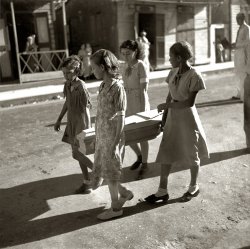
MAY CONTAIN NUTS

Search Shorpy
SHORPY ART

Framed or unframed, desk size to sofa size, printed by us in Arizona and Alabama since 2007. Explore now.
Join and Share
Ad-Free Shorpy
Shorpy is funded by you. Patreon contributors get an ad-free experience.
Learn more.

Recent comments
- Texas Flyer wanted
- Just a Year Too Soon
- WWII -- Replacing men with women at the railroad crossing.
- Yes, Icing
- You kids drive me nuts!
- NOT An Easy Job
- I wonder
- Just add window boxes
- Icing Platform?
- Indiana Harbor Belt abides
- Freezing haze
- Corrections (for those who care)
- C&NW at Nelson
- Fallen Flags
- A dangerous job made worse
- Water Stop
- Passenger trains have right of way over freights?
- Coal
- Never ceases to amaze me.
- Still chuggin' (in model form)
- Great shot
- Westerly Breeze
- For the men, a trapeze
- Tickled
- Sense of loneliness ...
- 2 cents
- Charm City
- What an Outrage
- Brighton Park
- Catenary Supports
Member Photos
The Shorpy
Print Emporium
Print Emporium
Search Shorpy
Search results -- 30 results per page
- A Friendly Game: 1938
- ... Reserve, Louisiana." 35mm negative by Russell Lee for the Farm Security Administration. View full size.
Hint of a Smile That guy ... Posted by Dave - 09/09/2011 - 6:36pm -
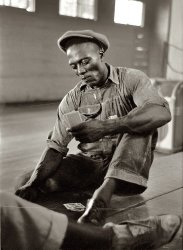
- Garage à Trois: 1940
- ... Medium format acetate negative by Russell Lee for the Farm Security Administration. View full size.
Now ain't this the ... Posted by Dave - 04/27/2020 - 9:58am -
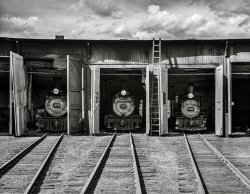
- The Boogie Woogie: 1940
- ... mail." From photos by Marion Post Wolcott documenting a Farm Security Administration camp for migrants working in Florida's vegetable fields ... Posted by Dave - 09/16/2013 - 6:55pm -
![The Boogie Woogie: 1940 June 1940. "Some of the younger Osceola migratory camp members who have come to the Belle Glade post office for their mail." From photos by Marion Post Wolcott documenting a Farm Security Administration camp for migrants working in Florida's vegetable fields and tomato canneries. View full size.
Needs another tagPretty Girls, to be specific. She's a real looker.
[Done. - Dave]
Times ChangeThis would be "Far-Out" 35 years later.
Wind wings-Her 1930-31 Ford Model A Roadster once had them, as evidenced by the empty bracket at the base of her folded windshield; in this view the bracket looks something like an airplane propeller with two blades. My Model A Ford still has them in place, which secures the glass by compression of the screw holding the bracket. Hope someone, somewhere is still enjoying The Boogie Woogie car.
Nice rat rod'30-'31 Ford roadster, missing its instrument cluster fascia and, no doubt, a few other things. Can't believe it looks so bad after only a few years, but car design had made huge advances since 1927, when the Model A was designed.
Today, this would not be out of place in a hot rod show. There are actually custom car painters who specialize in adding what they call "patina," which means fake rust. Don't know why. Real rust is cheap enough, and easy to find.
(The Gallery, Cars, Trucks, Buses, Florida, M.P. Wolcott, Pretty Girls)](https://www.shorpy.com/files/images/SHORPY_8c30447u.thumbnail.jpg)
- London Bridge: 1940
- ... format acetate negative by Marion Post Wolcott for the Farm Security Administration. View full size.
Sorry, ma'am -- But ... Posted by Dave - 07/11/2019 - 10:01am -
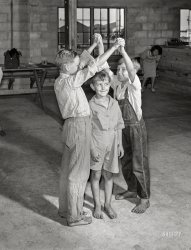
- When Pigs Fly: 1939
- ... keep the flies away." Photo by Marion Post Wolcott for the Farm Security Administration. View full size.
Someone survived and prospered ... Posted by Dave - 05/08/2019 - 2:59pm -
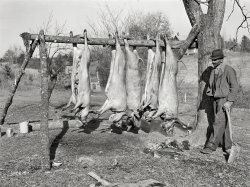
- Family Farmers: 1939
- October 1939. "Family of Fred Schmeeckle, Farm Security Administration borrower, on their dryland farm in Weld County, Colorado." ... Posted by Dave - 01/11/2018 - 12:38pm -
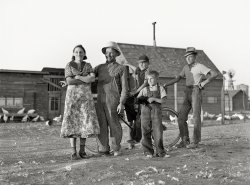
- No Trespassing: 1939
- ... behind the town." Acetate negative by John Vachon for the Farm Security Administration. View full size.
Photographer could not care ... Posted by Dave - 10/31/2020 - 4:04pm -
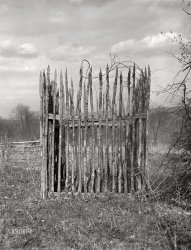
- The Scenic Route: 1941
- ... City, Colorado." Photo by Marion Post Wolcott for the Farm Security Administration. View full size.
Disclaimer "Professional ... Posted by Dave - 02/14/2020 - 6:16pm -
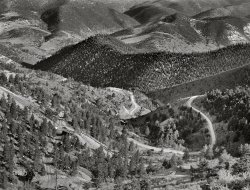
- Desperado: 1941
- ... Oregon." 35mm acetate negative by Russell Lee for the Farm Security Administration. View full size.
Regrets "If only I hadn't ... Posted by Dave - 09/13/2020 - 12:15pm -
![Desperado: 1941 July 1941. "Store with cap guns and fireworks for sale, Fourth of July, Vale, Oregon." 35mm acetate negative by Russell Lee for the Farm Security Administration. View full size.
Regrets"If only I hadn't spent all my money on licorice twists!"
I give upWhat in the world is on the front of this young man?
[A dog. - Dave]
Cap RollsThe "ammo" for a cap gun is a roll of red paper with small amounts of explosive powder. The smell of the smoke emitted along with the shot was part of the experience.
"A dog"A plaster dog, at that. I bet his mother just loved it! Well, at least it didn't need to be housebroken.
HubleyA first-rate brand. Ask the kid who owned one.
Very nice inventory, I am partial to the pearl handled 1911.
General Patton would not approve ... of pearl grips on a cap gun. And while I like a good Hubley, I'm a Fanner 50 man.
(The Gallery, July 4, Kids, Russell Lee, Stores & Markets)](https://www.shorpy.com/files/images/SHORPY-8a30286a.thumbnail.jpg)
- Grandfather of All: 1935
- ... Medium format nitrate negative by Arthur Rothstein for the Farm Security Administration. View full size.
Standing in the way of ... Posted by Dave - 12/06/2015 - 7:39pm -
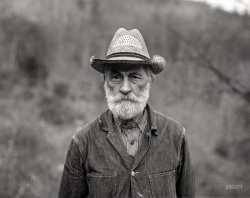
- La Casa Enchilada: 1940
- ... Mogollon, New Mexico." Photo by Russell Lee for the Farm Security Administration. View full size.
The Conversation Just After ... Posted by Dave - 08/21/2018 - 11:31am -
![La Casa Enchilada: 1940 June 1940. "Detail of front of store building. Mogollon, New Mexico." Photo by Russell Lee for the Farm Security Administration. View full size.
The Conversation Just After"C'mon in for a spell", the man with the dirty apron said, waving around a glass with some tired foam on it.
"Nah, can't. Got work to do." said the photographer, feeling he'd been caught. "Government work. It's important. Might be famous someday."
"What do you think I'm sayin, bud? I'm makin some more signs here and I need some help. I need a spell checker."
[And that's when the photographer told him about a job opening in Montana. - Dave]
Just askin'Do you get an enchilada or two if you board there? Looking at the prices, it might be a good deal if they're any good.
Travel book releaseTitled "Mogollon, New Mexico, on $1.40 per day." The bench may not look too sturdy and the curtains double as dish towels (or vice versa) but where else can you take a vacation including food and lodging for that price?
I wonder... if irregular boarders got a discount.
Grill MarksGiven that bench is made out of straps of sheet metal, it's a wonder anyone ever actually sat on it.
An interesting little town!... but the road to get there is not for the faint-hearted!
It Still StandsIf you go to street view, it's known as the Old Kelly Store. It's easy to find in such a small area. It's been patched oa bit over time.
(The Gallery, Eateries & Bars, Russell Lee, Small Towns)](https://www.shorpy.com/files/images/SHORPY-8b25544a.thumbnail.jpg)
- Coal Miner's Son: 1939
- ... View full size. 35mm nitrate negative by John Vachon, Farm Security Administration.
Interesting... Interesting. I did not know ... Posted by Dave - 12/11/2007 - 9:40pm -
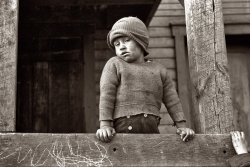
- Colored Lunch: 1940
- ... Avenue)." 35mm nitrate negative by Jack Delano for the Farm Security Administration. View full size.
Memories of Jim Crow This ... Posted by Dave - 09/07/2012 - 7:25pm -
![Colored Lunch: 1940 June 1940. Washington, D.C. "Entrance to colored drivers' lunchroom at a truck service station on U.S. 1 (New York Avenue)." 35mm nitrate negative by Jack Delano for the Farm Security Administration. View full size.
Memories of Jim CrowThis picture reminds me of the first time that I really became aware of racial bias. I was born and raised in Kansas and had never been exposed to the fact of bias against black people. We had black students in our highschool and no one had ever intimated that blacks were to be discriminated against. They were just the same as the rest of us and only working to survive like we whites.
My family took a trip to Tennessee one summer in about 1956 and, during the trip, we stopped at a drive-in on a Sunday noonday for a meal. Black people could not get curb service and had to go around to the side of the drive-in for their order. Most of them had just come from church and were very nicely dressed. My family, being white, got curb service. Another car pulled in alongside of us loaded with,what I can only describe as, white-trash. They got their order delivered to them. They were throwing trash and bones out of the windows, screaming and yelling, they looked like they hadn't taken a bath or cleaned up in over a week. But, yet, they got curb service and the very nicely dressed blacks had to go around to the side window for service. That's when I first became aware of discrimination and didn't like it.
Pretty Old BoxIn 1893, P.J. Dreher and his son, the "father of the California citrus industry" Edward L. Dreher, formed the Southern California Fruit Exchange. By 1905, the group represented 5,000 members, and renamed itself the California Fruit Growers Exchange. In 1908, it changed its name to Sunkist Growers, Inc.
I wonder what the sign painter felt as he painted these instructions on the door? Jeb70 made me think about discrimination growing up, poverty takes precedence over discrimination, we were all equal when we were poor.
Obsession??Dont know who is more obsessed by the Rt 1 truck stop, Shorpy or Jack Delano. Can we lighten up a little?
[L'Obsédé, c'est vous. -Dave]
Crossing the BayAs a New York kid visiting my grandmother in Portsmouth, I took the ferry from the Eastern Shore to the Norfolk area. I simply did not know what to think of Whites Only water fountains or Colored Only restrooms.
Less than 6 degrees of separation Interesting that Edward L. Dreher should be mentioned here, as I married his grand-daughter's step-daughter. I guess that made him my step-great-grandfather-in-law, and his father Peter John Dreher my step-great-great-grandfather-in-law.
As to who was the "Father of the California citrus industry," it was Peter J. Dreher—and not his son Edward—who was responsible for organizing the industry. A summation of Edward's oral history of his father was misread and over 5,000 websites have copied the error word-for-word. Edward gave his father all the credit.
(The Gallery, D.C., Eateries & Bars, Jack Delano)](https://www.shorpy.com/files/images/SHORPY_8a34469a1.thumbnail.jpg)
- West of Fargo: 1939
- ... of Fargo, North Dakota." Photo by Arthur Rothstein for the Farm Security Administration. View full size.
Highway Hypnosis Better ... Posted by Dave - 08/27/2018 - 9:10pm -
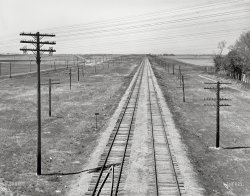
- Kentucky Tavern: 1940
- ... format acetate negative by Marion Post Wolcott for the Farm Security Administration. View full size.
No food, no gas The Tom ... Posted by Dave - 11/07/2019 - 7:17pm -
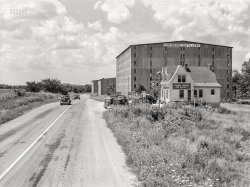
- Des Moines: 1940
- ... full size. 35mm nitrate negative by John Vachon for the Farm Security Administration.
All Together Now Now all together, put your ... Posted by Dave - 05/29/2008 - 1:10am -
![Des Moines: 1940 May 1940. "Afternoon, downtown Des Moines, Iowa." View full size. 35mm nitrate negative by John Vachon for the Farm Security Administration.
All Together NowNow all together, put your right foot forward. Hmnnn, how did Busby Berkeley, I mean John Vachon ever get all them folks to synchronize like that, now that's a photographer.
Des MoinesDoes anyone know where in Des Moines this is? I'm sure it's downtown. I tried to search for Hotel Franklin, but came up with nothing.
[The Hotel Franklin was at Fifth and Locust. - Dave]
Hotel FranklinThe image is looking north on 5th Avenue at Locust. One can tell the direction and street by the bend in the road in the near distance. In the downtown area, only streets on the north edge (mostly numbered streets) bend that way.
The Franklin Hotel became a rat trap by the '70s and was torn down toward the end of that decade or in the 1980s.
The people look reasonably well-dressed, but so thin -- almost gaunt in some cases. Busby Berkeley indeed.
(The Gallery, John Vachon)](https://www.shorpy.com/files/images/8a06255u.thumbnail.jpg)
- Colonial Esso: 1940
- ... Medium format acetate negative by Jack Delano for the Farm Security Administration. View full size.
Reconfigured I've been ... Posted by Dave - 07/23/2021 - 10:53pm -
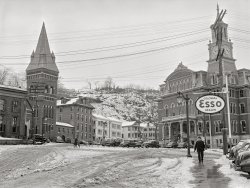
- All Aboard the School Truck: 1935
- ... on the way to school. 35mm negative by Ben Shahn for the Farm Security Administration. View full size.
Can You Hear Me? How funny. ... Posted by Dave - 09/09/2011 - 12:21pm -
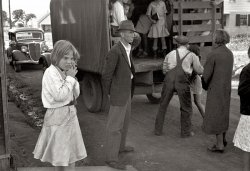
- Truckin': 1939
- ... Medium format acetate negative by John Vachon for the Farm Security Administration. View full size.
Refrigerated trailers ... Posted by Dave - 04/18/2020 - 6:50pm -
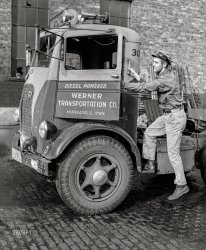
- Union Stockyards: 1941
- ... Medium format acetate negative by John Vachon for the Farm Security Administration. View full size.
View from the El platform ... Posted by Dave - 02/06/2020 - 12:23pm -
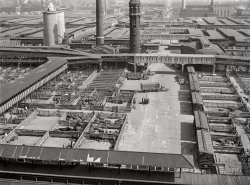
- Industrial Iowa: 1939
- ... in Des Moines, Iowa." Photo by Arthur Rothstein for the Farm Security Administration. View full size.
Minnie & Louie ... Posted by Dave - 01/20/2018 - 1:03pm -
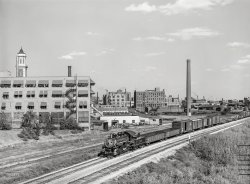
- Waiting for the Oranges: 1936
- ... Medium-format nitrate negative by Dorothea Lange for the Farm Security Administration.
Landon and Knox Assuming that is his car, I see ... Posted by Dave - 03/15/2008 - 8:17am -
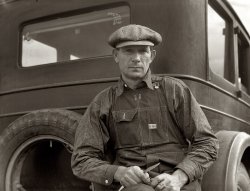
- Gone Fishin'
- ... 35mm Kodachrome transparency by Marion Post Wolcott, Farm Security Administration.
Even though it's not the Mississippi.... ... Posted by Dave - 09/12/2012 - 6:10pm -
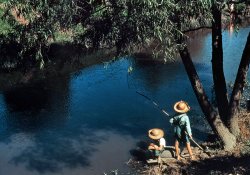
- Texas Saturday Night: 1942
- ... February 1942. Weslaco, Texas. Saturday night dance at the Farm Security Administration camp with music by the Drake family. View full size. ... Posted by Dave - 07/10/2009 - 12:38am -
![Texas Saturday Night: 1942 February 1942. Weslaco, Texas. Saturday night dance at the Farm Security Administration camp with music by the Drake family. View full size. Medium-format safety negative by Arthur Rothstein for the FSA.
FriskySeems like the young man dancing with the polka dot girl is getting a bit "handsy."
[That's two girls dancing. - Dave]
Wish I had a time machineOh, how I'd love to go to that dance!
Facial ExpressionI wonder what the woman in the center is thinking? She appears to have on a wedding ring, but they are dancing like they aren't too close. She doesn't look unhappy, but she is clearly thinking about something!
[Maybe the next call in the square dance. - Dave]
(The Gallery, Arthur Rothstein, Drake Family, Music)](https://www.shorpy.com/files/images/8b37738u1_0.thumbnail.jpg)
- Wasatch Range: 1940
- ... Summit County, Utah." Photo by Arthur Rothstein for the Farm Security Administration. View full size.
Which direction BillyB? I ... Posted by Dave - 02/18/2018 - 1:23pm -
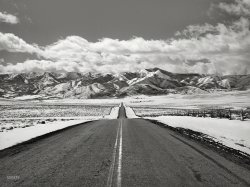
- Meet the Renningers: 1941
- ... format acetate negative by Marion Post Wolcott for the Farm Security Administration. View full size.
Cool kitty A very handsome ... Posted by Dave - 11/18/2019 - 11:17am -
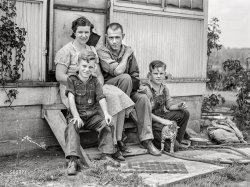
- West Memphis: 1935
- ... Memphis, Arkansas." 35mm negative by Ben Shahn for the Farm Security Administration. View full size.
Blind Musician It's a ... Posted by Dave - 03/29/2008 - 7:01am -
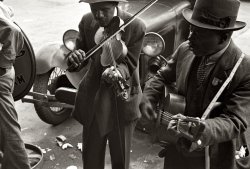
- Ice Dealer: 1941
- ... City." Medium format negative by Arthur Rothstein for the Farm Security Administration. View full size.
Alas, Doomed James "Tell of ... Posted by Dave - 06/25/2018 - 10:00am -
![Ice Dealer: 1941 December 1941. "Ice man. New York City." Medium format negative by Arthur Rothstein for the Farm Security Administration. View full size.
Alas, Doomed James"Tell of Seeing James Go to Doom in Flight Fight," the headlines scream.
Who among the Shorpyite sleuths might be able to pin down the date of the photograph from this tantalizing little clue?
(Flair enough; the flocus on these phlotographs are always a tad flidgety.)
PushcartsThe ice dealer was one of the few who plied the streets with their carts. The others were gathered into centers where they sold their wares. Mayor LaGuardia housed them in the Essex Street Market. The first pushcarts appeared on Hester Street in 1886. There were 10,000 street vendors at one time in NYC.
Grandpa did thisMy grandfather Anthony Sabbatini was the iceman in East New York, Brooklyn. Known as "Tony the Iceman" for years until he finally got a job with Railway Express, sort of like UPS of the 1930s. He was a strong stocky guy who must have climbed a million stairs delivering ice and packages. A hard life no matter how you look at it.
I still remember:Growing up on Belmont Avenue in the Bronx in the 1940s and seeing the ice man, the coal delivery trucks, the horse-drawn vegetable wagon, and the small wagon with the cage-enclosed merry-go-round for the kids. All going door to door offering their goods and services.
The leaping ramgives away the 1936 Dodge on the right. A universally recognized trademark, it is still in use both in name and image 82 years later.
Maybe ...If those are old newspapers that he's using for wrapping, could the headline refer to the sinking of the Reuben James?
[Yes, and he went down at Madison Square Garden. - Dave]
Looks like the placeWest 18th Street between Ninth and 10th avenues. A most unusual building in a neighborhood rapidly redeveloping itself. Old maps label this a gasholder house for the Manhattan Gas Company. It shows up on the earliest map I could find of this area, 1854, and could be a good deal older than that. An incredible survivor.
(The Gallery, Arthur Rothstein, NYC)](https://www.shorpy.com/files/images/SHORPY-8b16091a.thumbnail.jpg)
- Earth Rover: 1939
- ... format acetate negative by Marion Post Wolcott for the Farm Security Administration. View full size.
Thought I saw Hydraulics ... Posted by Dave - 04/22/2021 - 10:18am -
![Earth Rover: 1939 April 1939. "A whirling plough used by United States Sugar Corporation in soft powdery muck to prepare soil for planting sugarcane. Near Pahokee, Florida." Medium format acetate negative by Marion Post Wolcott for the Farm Security Administration. View full size.
Thought I saw HydraulicsBefore I enlarged the photo the springs that keep down force on the tool in the ground looked like hydraulic cylinders. Thinking it was early to see them. Further inspection shows the plough is moved by chains coming from the front of the machine. Possibly not even a diesel yet too. A friend of mine had a road grader on his property in Maine to service the miles long dirt road into his property. The machine was from about 1930 or so. A full size grader pretty much like you see today. It was powered by a four cylinder engine from a Model T. Back then it wasn't all brute power but more engineering and gearing. So much for the golf club carrying 600HP half ton pickups today.
[Here's a side view of this Caterpillar tractor. - Dave]
He has styleIf we could transport the driver to today, he could attend a steampunk party and fit right in.
Unique tractor The wide low ground pressure treads with a special grouser profile on the trackpads make this machine suitable to work the type of ground described. I would like to see the PTO arrangement on the front that powers those chains to lift that heavy booger of an implement.
In reply to Mark P, it is a Cat RD6 diesel. Three cylinders with pistons the size of small coffee cans and eight inches of stroke. It was governed at about 800 RPM but did its best work down about 600 with the throttle wide open. It had enough raw grunt to affect the rotation of the earth if you had it pulling in the right direction. The only thing using gasoline was the two cylinder pony motor used to start the main engine. For many years around many mining and construction sites the morning quiet was shattered by the sharp cracking exhaust of unmuffled Caterpillar pony motors.
It’s a dieselI took some time to look around and unfortunately can’t figure out which model this is but diesels in Cat products were very common back then. This one is definitely diesel since it has an injection pump and a 3 cyl engine as there are three injector lines. Cat made some gas stuff but by the middle of the '30s they made half of all the diesel power in the US.
(The Gallery, Agriculture, Florida, M.P. Wolcott)](https://www.shorpy.com/files/images/SHORPY-8c09820a.thumbnail.jpg)
- Pallbearers: 1938
- ... Medium format nitrate negative by Edwin Rosskam for the Farm Security Administration.
Eeriest I think this is the eeriest photo I ... Posted by Dave - 03/06/2019 - 11:31am -
